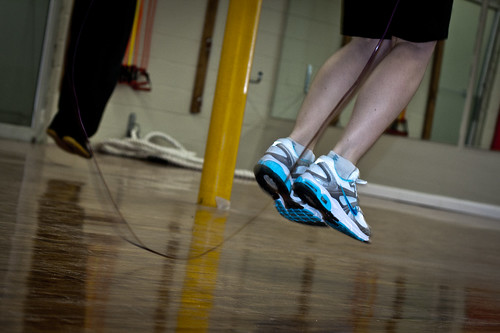
Boxing isn’t often the sport of choice for outdoor enthusiasts. You’re stuck in a crowded gym sucking in sweat-tainted air while listening to folks pound away at heavy bags. Not exactly pristine scenery.
But there a few benefits of adding the Sweet Science to your hiking training routine. I used to dabble in boxing a little and during that time I noticed that the way I trekked changed. My agility improved and I was able to trudge up inclines faster. I also had better stamina.
OK fitness gurus, I know what you’re going to say: hiking is primarily an aerobic exercise while boxing is about 80% anaerobic. And overall, both activities require two different training styles. That’s true. But by mixing up your fitness routine, keeping those muscles guessing while teaching them a few new skills, you can boost your hiking performance.
And you don’t necessarily have to trade blows in the ring (although, sparring is an awesome way to test your endurance). Here’s a quick rundown on how a little boxing training can help you up your hiking game.
Gain an unexpected cardio boost
So let’s deal with the whole aerobic/anaerobic issue right away. High-intensity exercise (like boxing) requires anaerobic energy that is produced without oxygen and is more limited and may only last a couple of minutes. Meanwhile, anaerobic exercise requires lots of oxygen and is more important for endurance activities.
So yes, if you’re training for a long trek you’ll want to focus on aerobic workouts– running, cycling, hiking (of course). But you shouldn’t ignore the anaerobic side of things completely.
The fast-paced exercise style that boxing is based on will help you trudge up short, steep inclines faster. This is because your body will become more efficient at doing things that involve short bursts of intense activity. And when you get to the top of the hill, you’ll be able to catch your breath quicker and without having to take a rest. Pretty much all of the exercises listed below will help you build your anaerobic cardio.
Strengthen your core for backpacking
Backpackers need a solid and flexible core. Your abs, back and obliques are the foundation for a proper body position in any sport, but ensuring they’re at full power is absolutely essential for backpacking — and it’s essential for boxing too.
A boxer needs an exceptionally strong core to endure crippling body shots and to help generate enough force behind their biggest punches. Boxers must rotate their bodies as they throw their strike to maximize the kinetic force behind each punch. And to really get some power behind each shot, you’ve gotta have a solid trunk. That’s why core exercise routines for boxing are often mind-numbingly brutal.
Sit ups, crunches and tossing around the medicine ball are just for starters. You can also work the heavy bag, since properly thrown punches require you to use your abs and obliques.
Exercises:
- Mix up continuous sets of crunches, sit ups and planks. Do as many as you can for about 60 seconds and then take a 30 second break. Repeat.
- Work the heavy bag focusing on bigger shots, such as long straight rights and hooks, for five three-minute rounds. Take a one-minute break between each round.
Build leg strength
My boxing coach would constantly yell at us ‘your punches come from your feet.’ What he meant was that your legs provide most of the power behind every shot you throw. To fire off a real haymaker, you’ve gotta push off the ground and shift your weight into the shot. And that means, you’ve gotta have strong legs.
But much like hiking, those giant, rippling bodybuilder legs won’t do you much good. All that bulk will make you tired far more quickly. So instead, focus on a high-rep workout and really make it burn.
Exercises:
- Jump rope on one leg for 10-15 seconds and then switch to the other leg. Do this for a typical amateur round (three minutes with a one-minute break). This exercise will strengthen your calves to help propel you up hills.
- Mix up squats and lunges, but go easy if you decide to hold weights.
- Do box jumps, with either one leg or two, to add another level of intensity while aiding agility.
Increase coordination & balance
Sugar Ray Robinson, Muhammad Ali and Manny Pacquiao are all known for having some of the best footwork in boxing. They slip around their opponents, flicking away from jabs and then sneaking inside to a deliver vicious combos. But having quick feet and keen balance can also help you skip over debris, leap from rock to rock or move deftly across a log bridge while hiking.
Exercises:
- Hit the heavy bag again, but this time concentrate on your footwork while maintaining balance as you throw your shots. Go heavy on the jabs, focusing on landing or pushing off with the ball of your feet as you throw each shot. Keep your back straight — a stiff spine provides better balance, whether you’re in the ring or on the trail — and focus on maintaining a shorter stance by keeping your feet closer together. Getting used to taking tighter steps will also help you tackle tricky terrain on the trail.
- Get a little crazy with the skipping rope. Try double-jumps or speed-skipping to get your toes moving quick.
Get tough with or without getting hit
Sure, boxers have a reputation as being tough guys and gals. But most fighters, at least at the amateur level, will tell you that the training routine for the match is often more painful than the battle itself (with a few exceptions, such as getting hit hard in the liver).
Using boxing to supplement your hiking training regimen makes you tougher because the workout is so demanding — not necessarily because you’re getting smacked in the head. However, sparring is an amazing way to really test your willpower as you push your cardio and energy reserves to the extreme. Just be prepared for the ‘hangover’ that comes the next day when you’re first starting out.
That’s actually what boxing and wilderness backpacking have most in common — if you want to test yourself, they can both provide a great way to find out what you’re really made of. So try them both and take your workout to a whole new level.
What Do You Think?
Do you do any exercises or play any sports that have helped you become a stronger hiker? Tell us about it in the comments below.


